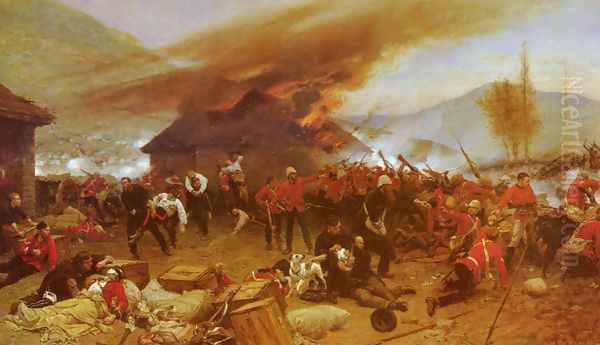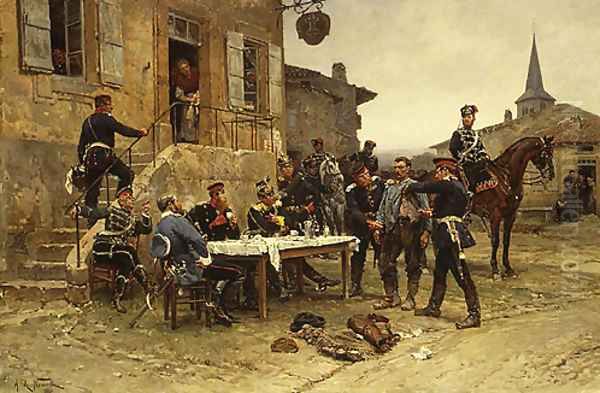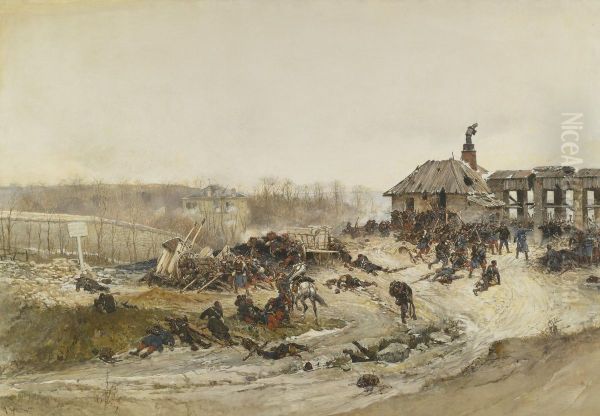Introduction: A Painter of National Sentiment

Alphonse-Marie-Adolphe de Neuville (1835-1885) stands as one of the most prominent French academic painters of the latter half of the 19th century, renowned primarily for his compelling and often intensely patriotic depictions of military life and historical battles. Emerging during a period of significant national upheaval and reflection, particularly following the Franco-Prussian War, Neuville captured the public imagination with works that blended meticulous realism with dramatic intensity. His canvases often focused on themes of heroism, sacrifice, and the grim realities of warfare, resonating deeply with a French populace grappling with defeat and yearning for national pride. While firmly rooted in the academic tradition, his work possessed a narrative power and emotional depth that secured his fame during his lifetime, making him a household name in France and earning him recognition abroad.
Early Life and Artistic Formation
Born in Saint-Omer, Pas-de-Calais, on May 31, 1835, Alphonse de Neuville came from a prosperous and well-educated family. His parents initially envisioned a more conventional career path for him, steering him towards legal studies after he completed his bachelor's degree. However, young Alphonse harbored artistic ambitions. His innate talent began to surface during his time at the naval school in Lorient, although his stay there was brief. Despite familial expectations, his passion for art proved irresistible.
Yielding to his artistic inclinations, Neuville sought formal training. He entered the studio of François-Édouard Picot, a respected painter working within the Neoclassical tradition, known for historical and religious subjects as well as large government commissions. Picot's studio provided Neuville with a solid grounding in academic drawing and composition. However, Neuville's artistic temperament was perhaps more aligned with the dynamism and emotional expressiveness of Romanticism. He is known to have spent a short period receiving guidance or advice from the great Romantic master, Eugène Delacroix, whose influence, particularly in the use of color and dramatic composition, can be discerned in Neuville's later work. This blend of Picot's academic rigor and Delacroix's romantic sensibility would shape his unique artistic voice.
From Illustrator to Painter

Like many artists of his time, Neuville initially found work as an illustrator to support himself and hone his skills. This early phase proved crucial in developing his narrative abilities and his eye for detail. He contributed illustrations to several popular publications, gaining valuable experience in visual storytelling. Among his notable commissions were illustrations for editions of Jules Verne's adventure novels, including the iconic Twenty Thousand Leagues Under the Sea, published by Pierre-Jules Hetzel. His drawings brought Verne's fantastical underwater world and Captain Nemo's exploits to life for countless readers.
Neuville also lent his talents to historical works, most significantly providing illustrations for François Guizot's widely read Histoire de France (History of France). This work required careful historical research and the ability to depict past events convincingly, skills that would serve him well in his later career as a military painter. This period of illustration work, while perhaps seen as secondary to fine art painting by some, was instrumental in refining his draughtsmanship and his capacity to construct complex, engaging scenes. He shared this path with other notable figures like Gustave Doré, who also achieved fame through illustration before, or alongside, their painting careers.
The Crucible: The Franco-Prussian War and Artistic Focus
The Franco-Prussian War of 1870-1871 marked a definitive turning point in Neuville's life and art. The swift and humiliating defeat of France by Prussia sent shockwaves through the nation, leading to the fall of the Second Empire and the establishment of the Third Republic. This period of national trauma profoundly impacted French society and culture. Neuville himself experienced the war firsthand, serving briefly as an engineer officer on the staff of General Caussade, participating in the defense of Paris, particularly at Le Bourget.
Witnessing the conflict, the suffering of soldiers, and the moments of desperate courage solidified his commitment to military painting. The war provided him with a wealth of subject matter, but more importantly, it tapped into a deep wellspring of national sentiment. In the aftermath of the defeat, there was a strong public appetite for art that commemorated French bravery, however futile, and fostered a sense of resilience and patriotism – a sentiment often referred to as revanchism. Neuville became a leading artistic voice for this feeling. He dedicated himself to depicting episodes from the war with an emphasis on the heroism and endurance of the common French soldier, often choosing moments of intense struggle or noble sacrifice. His method involved meticulous research, visiting battlefields, studying uniforms and equipment, and interviewing veterans to ensure the accuracy of his portrayals.
Masterpieces Forged in Defeat: Key Works

Neuville's reputation soared in the years immediately following the war, largely due to a series of powerful paintings depicting key moments from the conflict. These works cemented his status as a master of the military genre.
The Last Cartridges (Les Dernières Cartouches)
Perhaps his most famous work, Les Dernières Cartouches, exhibited at the Paris Salon of 1873, became an instant sensation. The painting depicts a harrowing scene from the Battle of Bazeilles (part of the larger Battle of Sedan), where a small group of French marines makes a desperate last stand inside a village house, known as the "Maison des Dernières Cartouches" (House of the Last Cartridges). Neuville masterfully conveys the claustrophobic atmosphere, the exhaustion and determination of the soldiers, and the grim finality of their situation as they count out their few remaining bullets. The painting was lauded for its realism, emotional impact, and patriotic spirit. It earned Neuville the Legion of Honour and became an enduring symbol of French tenacity in the face of overwhelming odds. Interestingly, its raw depiction of recent defeat was so potent that the French government, concerned about diplomatic sensitivities with Germany, briefly considered banning its exhibition, highlighting the painting's powerful resonance.
Bivouac before Le Bourget (Bivouac après le combat du Bourget)
Another significant work stemming from his personal experience was Bivouac before Le Bourget (or variations depicting the aftermath of the fighting there). Exhibited in 1872, this painting captures a different aspect of war – the quiet endurance and camaraderie of soldiers during a lull in the fighting, often under harsh winter conditions. Neuville focuses on the human element, showing the fatigue and resilience etched on the soldiers' faces as they huddle around campfires in the snow-covered landscape outside the contested village near Paris. It demonstrated his ability to convey pathos and atmosphere beyond the heat of battle.
The Cemetery of Saint-Privat (Le Cimetière de Saint-Privat)
Painted in 1881, this work addresses the brutal Battle of Gravelotte-St. Privat (August 18, 1870), one of the deadliest engagements of the war. Rather than depicting the fighting itself, Neuville focuses on the grim aftermath, showing French soldiers defending the churchyard wall of Saint-Privat-la-Montagne against advancing Prussians. The scene is one of intense, close-quarters combat amidst the tombstones, emphasizing the heavy cost and ferocity of the battle. It showcases Neuville's skill in composing complex, multi-figure scenes filled with action and detail, while maintaining a somber tone appropriate to the subject.
Other Franco-Prussian War Scenes

Neuville produced numerous other paintings related to the 1870-71 conflict, including Attack on a Barricaded House at Villersexel (1874), depicting another intense house-to-house fight, this time from a later phase of the war. These works consistently demonstrated his commitment to portraying the experiences of the French soldier with accuracy, drama, and patriotic fervor.
Artistic Style: Realism, Drama, and Detail
Alphonse de Neuville's artistic style is characterized by a compelling fusion of academic realism and dramatic storytelling. He possessed a remarkable technical facility, evident in the meticulous rendering of details – uniforms, weaponry, equipment, and the textures of the environment were all depicted with painstaking accuracy. This commitment to realism lent authenticity to his scenes, making the viewer feel like a witness to the events unfolding on the canvas. He often worked from sketches made on location or based on detailed accounts from participants, striving for historical veracity.
Beyond mere accuracy, Neuville was a master of composition and atmosphere. He skillfully arranged figures to create dynamic narratives, often using strong diagonal lines and contrasting light and shadow (chiaroscuro) to heighten the sense of drama and guide the viewer's eye. His depiction of smoke from gunfire, explosions, and the effects of weather – rain, snow, mud – contributed significantly to the immersive quality and emotional tone of his paintings. He captured the tension, fear, exhaustion, and determination on the faces and in the body language of his subjects, elevating his work beyond simple reportage to poignant human drama. While contemporaries like Ernest Meissonier were known for an almost miniature-like precision, Neuville often employed a slightly broader, more vigorous brushstroke that enhanced the energy of his battle scenes. His focus remained squarely on the human experience within the larger conflict, a characteristic that distinguished his work.
Collaboration and the Parisian Art World
Neuville operated within the vibrant, competitive art world of late 19th-century Paris, dominated by the official Salon system. He achieved considerable success within this system, exhibiting regularly and gaining critical acclaim. He was often discussed alongside the other leading military painters of the era, most notably Ernest Meissonier and Édouard Detaille. Meissonier, older and immensely famous, was known for his highly detailed historical and military scenes. Detaille, closer in age to Neuville, became his friendly rival and occasional collaborator. Both Neuville and Detaille specialized in contemporary military subjects, particularly those related to the Franco-Prussian War, and together they largely defined the genre in France during this period.
While distinct in their individual styles, Neuville and Detaille shared a commitment to accuracy and patriotic themes. Their prominence placed them at the forefront of Academic painting, alongside other Salon stars like Jean-Léon Gérôme, known for his historical and Orientalist subjects executed with photographic precision, and the highly popular figure painters William-Adolphe Bouguereau and Alexandre Cabanel. Neuville's focus on military themes set him somewhat apart, but his technical skill and narrative power earned him respect within this establishment, even as Impressionism, led by artists like Claude Monet and Edgar Degas, was challenging academic conventions elsewhere in Paris.
The Spectacle of the Panorama
In the late 19th century, panoramas – enormous, 360-degree paintings housed in purpose-built circular buildings – were a hugely popular form of public entertainment, offering immersive visual experiences akin to modern IMAX cinema. Neuville, in collaboration with Édouard Detaille, embraced this medium, bringing their expertise in military depiction to a grand scale.
Their most famous collaborations were The Panorama of Rezonville (also known as the Panorama of Mars-la-Tour) and The Panorama of Champigny. These immense canvases depicted major battles from the Franco-Prussian War, surrounding the viewer with meticulously detailed scenes of cavalry charges, infantry assaults, and artillery fire. Creating these required not only artistic skill but also significant logistical coordination. These panoramas were immensely successful, drawing large crowds in Paris and other cities, further cementing Neuville's and Detaille's fame and bringing vivid, if idealized, representations of the recent war to a wide audience.
Beyond France: Depicting Other Conflicts
While the Franco-Prussian War remained his primary focus, Neuville also turned his attention to other historical and contemporary conflicts, demonstrating the breadth of his interest in military history and heroism. He painted scenes from the earlier Crimean War (1853-1856), contributing to the visual record of French involvement in that conflict alongside British forces.
Notably, he also depicted episodes from British colonial wars, finding a receptive audience in Great Britain as well as France. His most famous work in this vein is The Defence of Rorke's Drift (1880), portraying the celebrated stand by a small contingent of British soldiers against a large Zulu force during the Anglo-Zulu War of 1879. Painted with his characteristic attention to detail and dramatic flair, the work captured the heroism of the defenders and became incredibly popular in Britain, reproduced widely through engravings. This demonstrated his ability to engage with themes of courage and conflict beyond a purely French national context. Other works, like The Spy, showcased his talent for creating suspenseful narrative vignettes within a military setting.
Legacy and Historical Evaluation
Alphonse de Neuville enjoyed enormous popularity and critical acclaim during his lifetime. His paintings struck a chord with the French public, offering stirring images of national resilience and military virtue during a period of introspection and rebuilding. His work was widely disseminated through high-quality engravings and photographic reproductions, making his images familiar in households across France and beyond. He was a respected figure within the official art establishment, honored with awards and commissions.
However, his critical fortunes, like those of many successful Salon painters, declined significantly with the rise of Modernism in the early 20th century. Later generations of critics, championing avant-garde movements, often dismissed academic art, particularly military painting, as overly anecdotal, nationalistic, or lacking in formal innovation. Neuville's focus on a specific genre was sometimes seen as a limitation. Furthermore, changing attitudes towards war and nationalism after the cataclysms of the World Wars led to a reassessment of patriotic military art.
Despite this period of relative neglect, Neuville's historical significance and artistic merits have been increasingly recognized in recent decades. Art historians now acknowledge his exceptional technical skill, his mastery of narrative composition, and his role as a powerful visual chronicler of his time. His paintings are valued not only as artistic achievements but also as important historical documents, offering insights into 19th-century warfare, soldierly life, and the prevailing sentiments of the era. His influence can be seen in the work of later military painters, such as Paul Grolleron or Lucien-Pierre Sergent. Today, his major works are held in prestigious museum collections, including the Musée d'Orsay in Paris, the Metropolitan Museum of Art in New York, and the Hermitage Museum in St. Petersburg, ensuring his enduring legacy as a key figure in 19th-century French art. Alphonse de Neuville died relatively young, in Paris on May 18, 1885, leaving behind a powerful body of work that continues to engage viewers with its blend of historical detail and dramatic humanism.